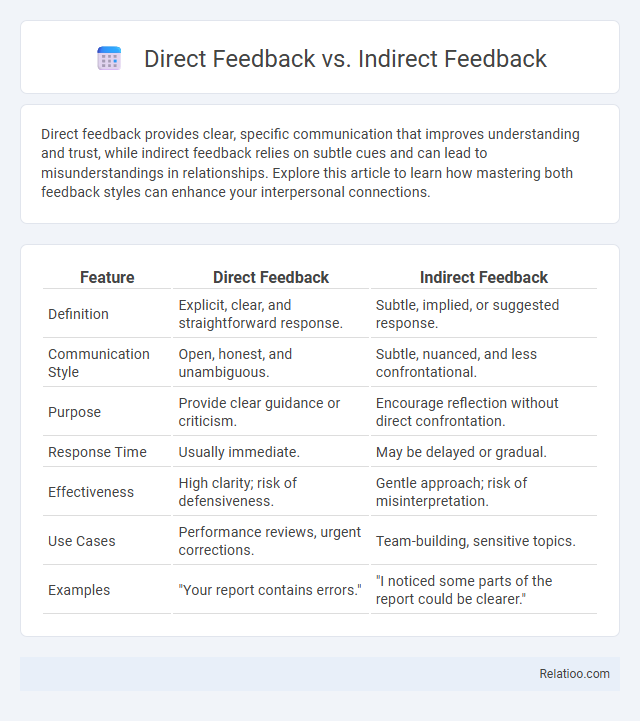Direct feedback provides clear, specific communication that improves understanding and trust, while indirect feedback relies on subtle cues and can lead to misunderstandings in relationships. Explore this article to learn how mastering both feedback styles can enhance your interpersonal connections.
Table of Comparison
| Feature | Direct Feedback | Indirect Feedback |
|---|---|---|
| Definition | Explicit, clear, and straightforward response. | Subtle, implied, or suggested response. |
| Communication Style | Open, honest, and unambiguous. | Subtle, nuanced, and less confrontational. |
| Purpose | Provide clear guidance or criticism. | Encourage reflection without direct confrontation. |
| Response Time | Usually immediate. | May be delayed or gradual. |
| Effectiveness | High clarity; risk of defensiveness. | Gentle approach; risk of misinterpretation. |
| Use Cases | Performance reviews, urgent corrections. | Team-building, sensitive topics. |
| Examples | "Your report contains errors." | "I noticed some parts of the report could be clearer." |
Understanding Direct Feedback
Direct feedback provides explicit, clear, and immediate information about performance or behavior, enabling faster comprehension and actionable responses. Indirect feedback, often subtle or implied, requires interpretation and may lead to uncertainty or delayed adjustments. Understanding direct feedback enhances communication efficiency, promotes transparency, and fosters more effective learning and development in professional and personal contexts.
What is Indirect Feedback?
Indirect feedback refers to responses or reactions that are not explicitly stated but inferred through actions, body language, or subtle cues, contrasting with direct feedback where information is straightforwardly communicated. It often involves observing behaviors or outcomes rather than receiving clear verbal or written comments. This type of feedback plays a critical role in environments where explicit criticism is avoided, emphasizing the importance of interpreting context and nonverbal signals.
Key Differences Between Direct and Indirect Feedback
Direct feedback provides explicit, clear, and immediate information about performance or behavior, enabling quick understanding and response. Indirect feedback is subtle, often implied through non-verbal cues or contextual hints, requiring interpretation and deeper analysis. The key difference lies in the clarity and immediacy of communication, with direct feedback fostering transparency and immediate corrective action, while indirect feedback allows for more nuanced, less confrontational guidance.
Advantages of Direct Feedback
Direct feedback provides clear, immediate information that helps you quickly identify areas for improvement and make necessary adjustments. It minimizes misunderstandings by delivering specific, actionable insights, enhancing learning and performance efficiency. Direct feedback also fosters open communication, building trust and encouraging continuous growth.
Benefits of Indirect Feedback
Indirect feedback allows individuals to receive insights through observation and third-party input, promoting self-reflection and intrinsic motivation. This subtle approach minimizes defensiveness, fostering a more open mindset and long-term behavioral change. Unlike direct feedback, indirect feedback enhances communication by creating a supportive environment for continuous learning and growth.
Challenges in Giving Direct Feedback
Giving direct feedback often presents challenges such as the potential to provoke defensive reactions or damage interpersonal relationships, especially in hierarchical environments. It requires clear communication skills and emotional intelligence to ensure the recipient understands the message without feeling attacked or demoralized. Balancing honesty with empathy remains a critical challenge in delivering effective direct feedback.
Potential Drawbacks of Indirect Feedback
Indirect feedback can often lead to misunderstandings and ambiguity, as the message is not explicitly stated, causing confusion about performance expectations. This lack of clarity may result in decreased motivation and slower improvement since recipients might misinterpret the feedback or fail to recognize areas needing change. Unlike direct feedback, indirect feedback's subtlety can diminish its effectiveness in driving actionable results and fostering transparent communication.
When to Use Direct Feedback
Direct feedback is most effective when immediate, clear communication is required, such as during performance reviews or urgent project corrections to ensure your message is understood without ambiguity. Indirect feedback suits situations where a softer approach is needed, like encouraging self-reflection or when cultural context discourages confrontation. Understanding when to use direct feedback empowers you to communicate more effectively and achieve desired outcomes promptly.
Situations Favoring Indirect Feedback
Indirect feedback is favored in situations requiring subtlety, such as addressing sensitive topics or preserving interpersonal harmony within teams. It allows individuals to reflect and self-correct without feeling publicly criticized, often used in hierarchical workplaces or cultures emphasizing face-saving. This approach is effective for fostering long-term behavioral change while minimizing defensiveness and resistance.
Choosing the Right Feedback Approach
Choosing the right feedback approach depends on the context, communication style, and desired outcomes. Direct feedback provides clear, specific guidance, enhancing performance by addressing issues promptly, while indirect feedback uses subtle cues to encourage reflection without confrontation, beneficial in sensitive situations. Balancing transparency and tact ensures that feedback effectively motivates improvement and maintains positive relationships.

Infographic: Direct Feedback vs Indirect Feedback
 relatioo.com
relatioo.com